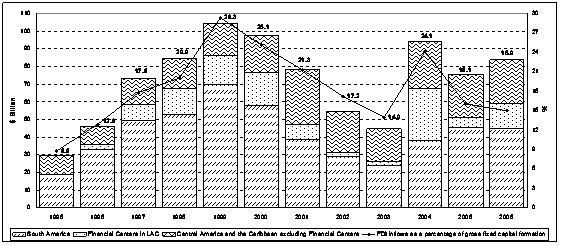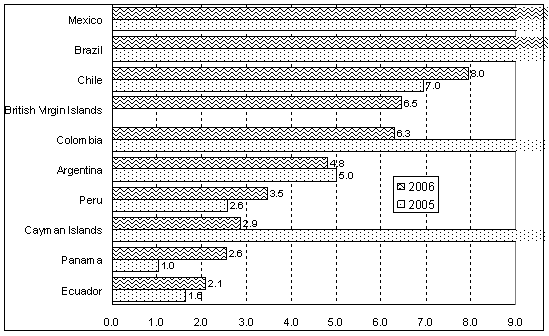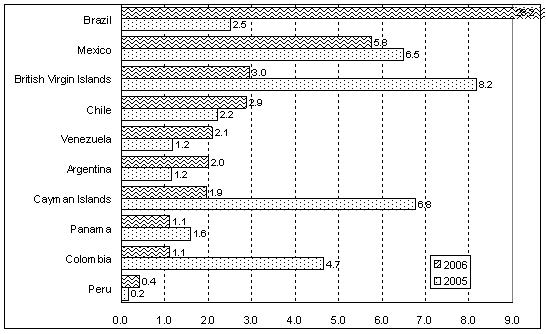| EMBARGO The contents of this press release and the related Report must not be quoted or summarized in the print, broadcast or electronic media before 16 October 2007, 17:00 GMT (1PM New York, 19:00 Geneva, 22:30 New Delhi, 02:00 17 October Tokyo) |
Foreign direct investment (FDI) inflows to Latin America and the Caribbean rose by 11% to US$84 billion in 2006 (figure 1), but the increase was almost entirely attributable to investment in the region´s offshore financial centres, UNCTAD reports in its annual review of FDI trends around the world. FDI outflows from Latin America and the Caribbean, excluding those from offshore financial centres, surged to $43 billion in 2006, an increase of 125%.
The World Investment Report 2007 (WIR) notes that if offshore financial centres are excluded, FDI inflows remained unchanged for South America (at $45 billion) and Central America and the Caribbean (at $25 billion). Brazil and Mexico remained the two main recipient countries, with $19 billion in FDI inflows each (figure 2). The report also finds that reinvested earnings are becoming a major component of inward FDI, in particular to South America, as a result of strong increases in the profits of foreign affiliates.
This year´s report is subtitled Transnational Corporations, Extractive Industries and Development (1).
There is some variance in FDI trends by subregion and by sector. In South America, most countries registered high FDI growth rates - for example, Bolivia (from negative to positive values), Brazil (25%), Chile (14%), Ecuador (27%), Paraguay (33%), Peru (34%) and Uruguay (62%) - but these were offset by large decreases in two countries: Colombia (-39%) and Venezuela (negative FDI inflows). Argentina was the only country where FDI inflows remained relatively stable -- they declined 4%. In Central America and the Caribbean (excluding offshore financial centres), Mexico saw a slight decline but nevertheless still accounted for three quarters of all FDI into this subregion. The decrease in Mexico was compensated for by increased flows to such destinations as Costa Rica (71%) and the Dominican Republic (16%). Other countries in the sub-region received less than $1 billion each in FDI inflows.
With the exception of offshore financial centres, the manufacturing sector continued to draw the largest share of inward FDI in Latin America and the Caribbean, with particular dynamism apparent in resource-based activities such as sugar refining, mineral refining, metallurgy, petrochemicals, and pulp and paper production. Manufacturing was followed by the services sector, where a number of existing foreign companies expanded their activities, acquired new assets, or established new operations in the region which more than compensated for withdrawals by other foreign firms, especially from the electricity industry. The primary sector remained attractive to foreign investors because of persistent high commodity prices, although changes in regulations have to some extent dampened investors´ enthusiasm in some countries, and inflows in 2006 fell slightly.
The trend in the region towards a greater economic role for the state continued in 2006 in the extractive industries, and even extended to other industries such as electricity and telecommunication, which are considered "strategic" in Bolivia and Venezuela. By contrast, in Colombia the Government decided to revitalize its privatization programme of the 1990s and launched a series of sales of state assets related to financial services and telecommunications.
FDI inflows to Latin America and the Caribbean -- again excluding offshore financial centres -- are expected to increase moderately in 2007, driven mainly by the establishment of manufacturing or other economic activities new to the region (known as greenfield investments). High commodity prices and strong regional economic growth are expected to continue, but it is not anticipated that cross-border mergers and acquisitions (M&As) will recover significantly, and the withdrawal of TNCs from service activities is likely to persist.
The surge in FDI outflows from Latin America and the Caribbean was led by Brazil, the source for $28 billion in outward investment (figure 3), the country´s highest level ever. For the first time, Brazil´s FDI outflows were higher than its inflows. The $17 billion purchase of Inco Ltd (a Canadian nickel producer) by the Brazilian mining company CVRD explains a large part of the increase. The second largest source of outward FDI was Mexico, which recorded $5.8 billion, concentrated in telecommunications. Chile, Venezuela and Argentina also invested over $2 billion each in business abroad.
The World Investment Report and its database are available online at http://www.unctad.org/wir and http://www.unctad.org/fdistatistics |
ANNEX
Tables and figures
Figure 1. Latin America and the Caribbean: FDI inflows and their in gross fixed capital formation, 1996-2006
Source: UNCTAD, World Investment Report 2007
Figure 2. Latin America and the Caribbean: FDI inflows, top 10 economies, 2005-2006a(Billions of dollars)
Source: UNCTAD, World Investment Report 2007
Note: a Ranked on the basis of the magnitude of the 2006 FDI inflows.
Figure 3. Latin America and the Caribbean: FDI outflows, top 10 economies, 2005-2006a(Billions of dollars)
Source: UNCTAD, World Investment Report 2007
Note: a Ranked on the basis of the magnitude of the 2006 FDI outflows.



